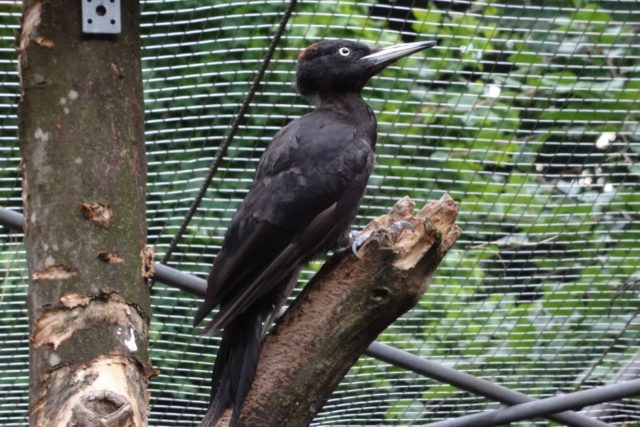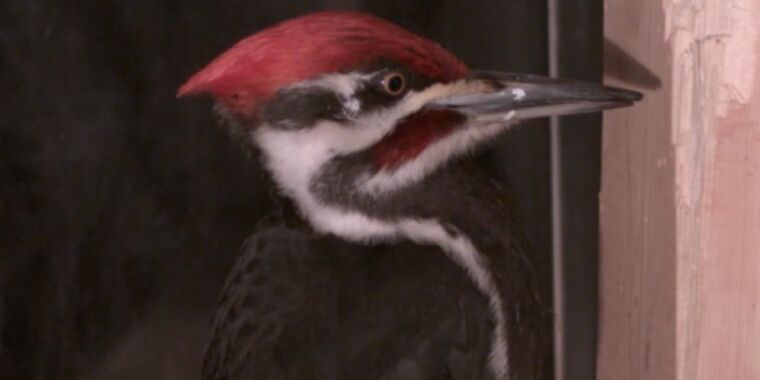Slow-motion video of pecking by the pileated woodpecker (Dryocopus pileatus). The original video was recorded at 1600 frames per second. Credit: Robert Shadwick & Erica Ortlieb/University of British Columbia
Check out almost any popular science article about woodpeckers and you’ll likely find some mention of why the birds don’t seem to suffer concussions, despite energetically drumming away at tree trunks all day with their beaks. Conventional wisdom holds that the structure of the woodpecker’s skull and beak acts as a kind of built-in shock absorber, protecting the bird from injury. But a new paper published in the journal Current Biology argues that this is incorrect and that woodpecker heads behave more like stiff hammers than shock absorbers.
“While filming the woodpeckers in zoos, I have witnessed parents explaining to their kids that woodpeckers don’t get headaches because they have shock absorbers built into their head,” said co-author Sam Van Wassenbergh of Universiteit Antwerpen, Belgium. “This myth of shock absorption in woodpeckers is now busted by our findings.”
As for why this particular myth has endured for so long, Van Wassenbergh told Ars, “To us humans, the first thing that comes to our mind when watching an animal violently smashing their head against trees is to wish the animal had some kind of a built-in cushioning to prevent it from getting headaches or concussions. It is logical for us to think of such action in terms of protection and safety, as if it is an accident.”
The shock-absorber hypothesis was not completely lacking in scientific merit. (One 2002 study even won an Ig Nobel Prize in 2006. I’ve written about the topic in the past.) It started with a 1976 Lancet paper by Philip R.A. May et al., proposing the woodpecker as a natural model for investigating the mechanisms of head injury and its prevention. Other studies have shown that woodpeckers can hammer on trees as much as 12,000 times a day during their mating season, an average of between 18 to 22 pecks per second.

Sam Van Wassenbergh/Universiteit Antwerpen
That kind of sudden, sharp blow can produce deceleration forces as high as 1,200 g’s. A human being will suffer a concussion with a sudden deceleration of 100 g’s. A 2006 study proposed that the orientation of the woodpecker’s brain within the skull increased the area of contact when pecking, thereby reducing stress on the brain. The birds’ small size is also a boon, given those acceleration speeds.
Micro-CT scans have revealed that woodpecker skulls boast thick muscles in the neck, sponge-like bones, and a third inner eyelid to keep the eyeball in place, which scientists assumed would work together to absorb impact and prevent injury from the incessant drumming. One 2011 study found that there is also another springy structure in the back of the skull called a hyloid, which could work in concert with cerebrospinal fluid to further suppress vibrations. Most recently, a 2021 study posited that the bird’s jaw apparatus might also act as a cushion during the pecking process.
Enter Van Wassenbergh, who decided to conduct his own research into the topic after being struck by the paradoxical nature of the shock absorber hypothesis. He reasoned that any absorption or dissipation of the head’s kinetic energy would actually impair the bird’s ability to hammer away incessantly. Since this drumming behavior is so central to the woodpecker’s ability to communicate and attract mates, it seemed unlikely that a built-in shock absorber would have evolved via natural selection.
“There was already skepticism in the scientific literature for a long time,” Van Wassenbergh said, dating all the way back to May’s 1976 paper. “May wrote, ‘If the beak absorbed much of its own impact, the unfortunate bird would have to pound even harder.’ The notion that the woodpecker head primarily needs to be a functional hammer made sense to me. From reading the literature, it appeared to me that cranial shock absorption has never been confirmed for live birds performing their natural behavior, despite that many sources reported this as a fact. This spurred me into conducting research on this topic.”








